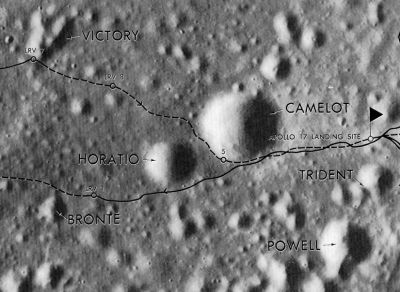Camelot
Contents
Camelot (Apollo 17 site craterlet name)
|
Lat: 20.2°N, Long: 30.7°E, Diam: 1 km, Depth: km, Rükl: 25 |
Apollo 17 Site Traverses Chart
Images
LPOD Photo Gallery Lunar Orbiter Images Apollo Images
- Mike Constantine's assembled panorama of Camelot and its boulders. Camelot crater is seen at left, in front of the North Massif and the Sculptured Hills. The East Massif (with Jack Schmitt in front of it) is at centre, the South Massif at right. This panoramic view is one of the most frequently reproduced and most well-known. A planetarium in the Netherlands shows a 360° projected version of it.
- Dave Byrne's assembled panorama of Camelot, which shows a northward view of the boulder cluster at the southern part of Camelot's rim. Source: Eric M. Jones's Apollo Lunar Surface Journal.
- David Harland's alternate assembled panorama of Camelot and the boulder cluster. Source: Eric M. Jones's Apollo Lunar Surface Journal.
Maps
(LAC zone 43D1) LAC map Geologic map LTO map
Description
The Landing Site Name "Camelot" is plotted on Topophotomap 43D1/S1 and Site Traverses chart 43D1S2.
- Camelot (crater) - "The kingdom of the legendary Arthur, whether real or not, represents the seed of freedom, compassion, and achievement that exists in mankind. It is possible that our own movement into space was in part inspired by the influence of this Arthurian seed on John F. Kennedy. In this case and others, the imperfections of Camelot accent the greatness of its goals." The crew of Apollo 17 visited Camelot during the second EVA, and Schmitt's lusty rendition of the Lerner and Lowe song as they approached it is memorable (source: APOLLO LUNAR SURFACE JOURNAL, Eric M. Jones).
Description: Wikipedia
Camelot (correct link)
Nomenclature
- Astronaut-named feature, Apollo 17 site.
- Perhaps interesting to know; somewhere in the solar system there seems to be an asteroid called Camelot (9500 Camelot).- DannyCaes Mar 23, 2013
- Four small craters east of Camelot and slightly west and southwest (or south?) of the LM's landing site seem to have been called Rudolph, Frosty, Poppie, and Barjea. Another group of small craters (5) north of Camelot seem to have been called Agricola, Lewis, Clark, Spirit, and Holden (source: APOLLO 17 Preliminary Science Report).- DannyCaes May 4, 2014
APOD Articles
Jack Schmitt (Apollo 17) running near the southern part of Camelot's bouldered rim
Bibliography
David M. Harland: EXPLORING THE MOON, the Apollo expeditions.
Eric M. Jones: APOLLO LUNAR SURFACE JOURNAL (ALSJ).
